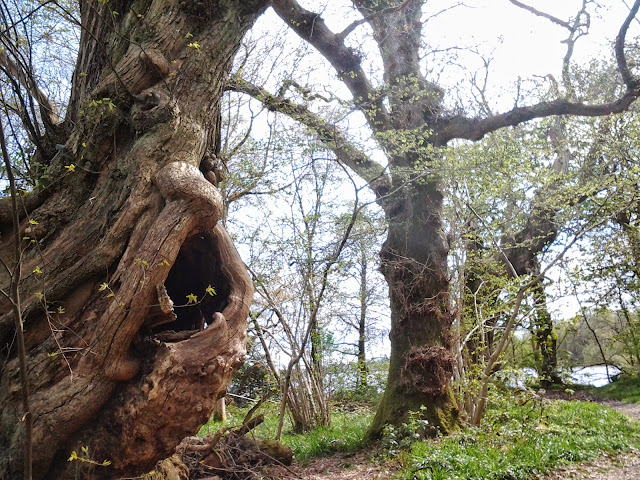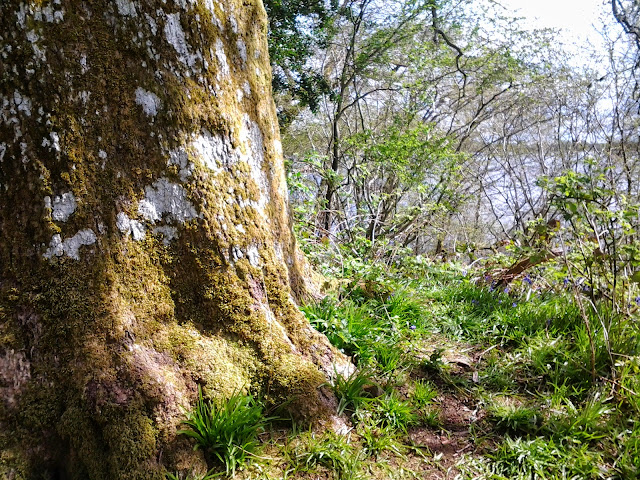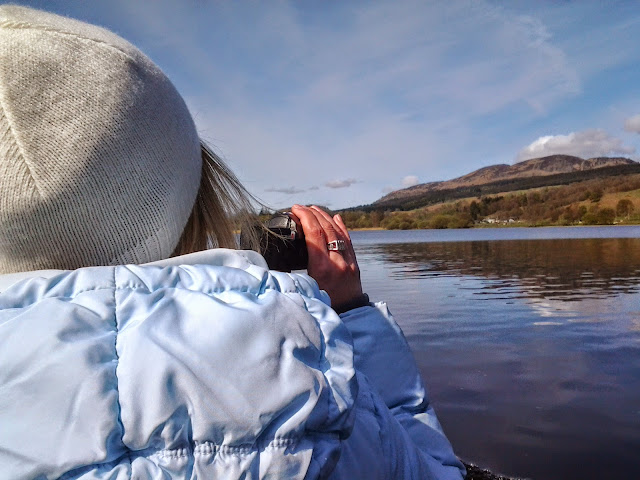Nun's Walk and Nun's Hill
Scottish Folklore
Inchmahome, a place of beauty and retirement— where Nature has richly displayed her varied charms— combined with the ever hallowed associations that are heard in every echo, that linger in every glen, that rest on the .heathery hillside, and are wafted back by every balmy breeze which floats around its shores — the Lake of Monteith, and the fairy islands that nestle on its bosom, stand alone in their glory.
Fabulous wall ruins everywhere, couldn't help but touch :o)
I wanted to return to the fallen tree in the picture below. It seemed very old, with lots of stories to tell.
'Hey Liz!' Snapshot ;o)
The whole island made us both feel uplifted
Chestnut trees at least 400 years old! Wow!
The Island of Inchmahome is beautifully wooded; many of the trees have attained an immense size, and have spread their antlered heads for ages over its hallowed soil. A number of these monarchs of the forest have yielded to the gale, and their gigantic trunks lie scattered over the soil that gave them birth, telling the spectator that the most noble of earth’s productions will eventually pass away.
The Nun's Hill is more like a mound. It is the only one on this side of the isle, beautiful!
There is a smaller mound, by the lake, nearer to ferry (same side) by the North side of Priory.
A gentle eminence, on the south-eastern corner of the island, bears the name of the “ Nuns’ Hill;” and on this knoll, it is said, the nuns used to disport themselves, and gather pebbles on the shore, during the intervals of their holy functions. A communication from the Nunnery—by a walk, guarded on each side by high walls, and still called the “Nuns’ Walk”—led to this place of retirement, and completely screened them from the vulgar gaze.
This mound appears to have been partly natural and partly artificial. It has finely sloping sides, with flat top, and a large oak tree spreads its withered arms around its summit; while, at the east side, a beautiful specimen of native fir hangs its green tresses over the ancient walk, once trod by holy feet alone.
Between a point on the south side of the island and the adjacent “Talla” or “Earl’s Isle,” there is an echo that will repeat several words at a time; and oft has this “hollow sound” returned the holy voice of a monk or nun, and sent back the thundering tones of a belted knight or warrior, or whispered from isle to isle the lisping accents of the virgin Queen, as the fairy thing sported along the pebbled shore.
(Photos further down)
A few more weeks and this will all be covered in Bluebells.
It will look like a carpet of purple flowers :o)
Liz was always ahead of me, as I kept stopping to take snapshots of trees and the view, lol.
A little further, and Liz found a slab of stone, marking the nun's folklore burial site. I'll add the story at the end of the blog post.
Liz and I left a couple of flowers on the slab - It felt very peaceful here
Coming down Nun's Hill (past Arnmach to Inch Talla Isle)
View to Inch Talla
The western half of the island united with “Talla,” the Earl’s residence, to form the Earl’s demesne; and, but a few years ago, Inchmahome could boast of a rare and beautiful orchard, but which has unfortunately been allowed to fall into decay. The tourist no longer looks upon the trees beneath whose boughs earls roamed, or monarchal hands plucked the golden fruit.
Taken from an old book -
(No buildings exist in this area now, but there are ruins of walls scattered around this part of the isle).
On the south of the Priory, stand the ruins of a large nunnery, said to be the oldest building on the island. It measures nearly one hundred feet long, and the lower storey has been arched over. One of the apartments, the kitchen, is still standing —the large chimney and fireplace being very entire. The windings of a stair which has reached to some high portion of the building can also be traced.
This building is traditionally called “ The Nunnery,” but for what reason I cannot discover, there being no note in history that there had ever been a nunnery or nuns on the island. Graham of Duchray says it was the “dwellings of the churchmen.”
On the south-western portion of the island, and surrounded by a broken-down wall, is the original flower garden of the Earls of Menteith. This plot of ground is thirty-five yards square, and in the centre stands a fine old boxwood tree, said to have been planted by Queen Mary.
Taking closer snapshots of Inch Talla castle ruins from Inchmahome isle
The story of the nun
A romantic height on the south side of Inschemachame, exists a place called the Nun's-hill.
A nun, who having fallen in love with a son of one of the first Earls of Menteith, resolved to throw aside the veil, break her vow, and leave the dungeons of Cambuskenneth for the sweets of Talla. A meeting had been arranged on this particular spot, and a boat provided on the eastern shore to take the nun to Inchmahome. But alas for love! a neighbouring clan invaded the Earl’s domain, and leading his father’s clansmen against the foe, the brave youth fell on the dark braes of Mondhuie. In his last moments, the youth unconsciously divulged to his confessor his meeting with the nun. Enraged at the insult offered to his church, the cruel monk resolved to be revenged.
Disguised as the young nobleman, he watched the arrival of the runaway nun. Well, ’twas a clear moonlight night when the monk threw aside the gown and cowl for a warrior’s dress, and took his place on the appointed spot. By-and-by a small black speck is seen on the Inchie shore; ’twas the nun in her lover’s boat. She, footsore and weary, had trod the plain from Stirling to the lake, and was now pushing her scallop over the tiny waves. Shortly the boat touched the sand, and the fair lady sprang into her supposed lover’s arms; but, alas! it was only to be hurled back to perish in the blue waters.
Next day the monks on the island had the body taken from the lake, and interred in an upright posture on the knoll—hence the “Nun’s Hill.” A large stone near the top of the hill marks the supposed spot. At a certain hour in the evening, tradition says, a dark figure may yet be seen treading the “Nuns’ Hill.”
The website has links and more info of the book road trip.
'A Carpet of Purple Flowers' is available to pre-order on Amazon HERE
Excerps of Summer at the Lake of Monteith from HERE
love and light
Trace
xoxo



















































































































































